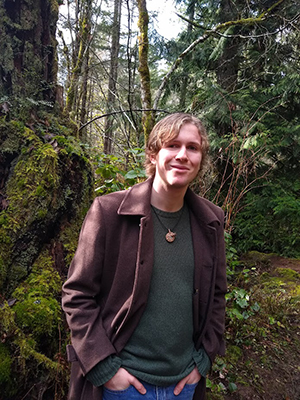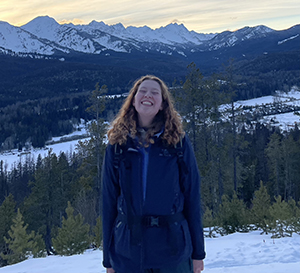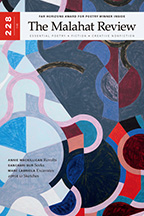Personal vs. Social Identity: Jane Frew interviews Dylan Clark

Screener Jane Frew talks with Dylan Clark, whose story “Safety” appears in our spring issue #226. They discuss the toxic ideals of patriarchal masculinity, relationships between behaviour and place, and how writing is an agent of cultural change.
Read an excerpt of "Safety" here.
Dylan Clark was born in Victoria, British Columbia on the un-ceded lands of the W̱SÁNEĆ, T’Sou-ke, Klallam, and Lekwungen peoples. He studied Writing and History at UVic and is currently studying Community Planning at UBC. Dylan has worked in a variety of jobs, including as a bookstore clerk, a farmhand, and a sailmaker. During his undergrad, he volunteered as a Vice Editor for the interdisciplinary student journal, The Warren. Primarily, he writes short stories and poems. Stylistically, he’s interested by absurd and fantastical writing, or writing that mimics the associative thinking of dreams, memories, and lies. Thematically, his writing investigates social and ecological relationships, bad choices, and speculative places. Dylan is interested in writing that is both political and aesthetic. Currently, he is trying to finish writing down more ideas than he can manage while finishing his graduate studies.
Your story “Safety” portrays a rigid, patriarchal, and starkly violent world. What inspired
you to create this troubling fictional reality? How did you begin to conceptualize this
story?
In terms of inspiration, the story came out of a place of frustration. On the one hand, I was feeling
personally frustrated. There’s a particular dynamic that emerges within male dominated workspaces
or social situations, which can be really uncomfortable, particularly as a queer/bisexual man but also
more generally for any person who dislikes the culture of machismo that emerges in those spaces.
You feel caught between the wish to be true to yourself and the safety of fitting in, or the inability
but desire to shift that dynamic. When I began the story, I was channelling anger at a recent instance
of being placed in that context, but also anger at all the times I’ve experienced it.
Less personally, I was feeling angry about gun violence and mass shootings. In the past decade or so in the U.S., there have of course been hundreds each year, effectively all of which are committed by men. Of course, there are a variety of factors in those attacks, most notably easy access to firearms and online radicalization by fascist, white supremacist groups. However, I think that there is also a strong connection between normative masculinity and gun violence. Violence, aggression, competition, and domination are all valued as ideals for patriarchal masculinity. To maintain masculine status within patriarchy, men engage in anti-social behaviour. The story is obviously more extreme than reality in some ways, but it is trying to exaggerate the real-world dynamics of patriarchal male socialization. I’ve been reading “The Will to Change” by bell hooks and it’s a very thoughtful investigation of the socialization of men, which I’d highly recommend.
The figure of the father and his melody haunt your character Jamie in this story. When he swallows the bullet casing, he sees it as an antidote for the “melody and doubt” associated with his father. Do you think the reverse is true, too—that what Jamie’s father represents is similarly an antidote for this “killing power” that permeates Jamie’s world?
In a sense, yes. During the enculturation of boys into patriarchal masculinity, a wide range of emotions and interests that are considered non-normative become abandoned. Boys learn to restrict their emotional worlds and their emotional expression in order to maintain status within a gender role that is inherently exclusionary. Necessarily, patriarchal masculinity is exclusionary, because patriarchy as an oppressive social structure requires exclusion and other-ing to serve its in-group (men).
While listening to a podcast called Scene on Radio, I was struck by one interview in particular in which a researcher commented on how men are brought up to be “half people.” According to the interviewee, before they can speak, boys learn that crying publicly is attached to social stigmatization. Men only learn to access “half” of their emotional world and limit themselves to particular activities and work that are masculine coded. While I was writing “Safety,” the father represented for me the capacity for boys and men to expand their understanding of self and become whole. Throughout the story, Jamie has difficulty understanding and navigating his assigned gender role. I wanted to imply that conforming to that role, in the way it has been assigned to Jamie, is not inevitable.
You chose a title for your story that seems thematically at odds with the story itself, begging the question of what it means to be “safe” in a violent world. Can you speak more to why you chose this title?
The title is a small play on words, which was meant to be suggestive of some of the story’s themes. On the one hand, safety is a state of being in which we are free from violence and harm. On the other, a safety is the switch on a gun that prevents it from being fired.
The story touches on various kinds and degrees of violence, including gun violence and socialization. In our own reality, there is a high correlation between men and acts of violence. So in one sense, I wanted to allude to the theme of masculine violence, and maybe also the hope to liberate masculinity from violence and anti-social behaviour.
Conversely, there is a safety in conforming to the norms of patriarchal masculinity. By choosing to conform, Jamie would be rewarded with social acceptance and the resulting privileges of patriarchy. Personal safety could, in a self-contradictory and negative way, mean the embrace of violence and social competition. Similar to a gun’s safety, the type of safety bestowed by privilege is unstable.
The socio-political reality in “Safety” presents the reader with an uncanny reflection of their own world. Does your background in History and Community Planning inform your writing process? How have your studies influenced your approach to writing?
It does. From those disciplinary lenses, I’m very interested in the relationships between behaviour and place, social structure and personal agency, as well as the process of cultural change. There is a strand of fiction that focuses primarily on the personal interior world of the individual, but I’m less drawn to that approach. Our relationship to social structure and culture—and the human influenced ecosystem (built or natural) that we’re enmeshed in—shapes and constricts who we can become. Conversely, those structures, physical and social, are in constant flux. Everything—from language, to geographical topology, to constructed monuments, to our worldviews—is in a state of change. Often, we propel that change, despite the restrictions of structure.
The tension between the personal and social is fascinating to me. I’m excited by stories that are social at their core and want to understand how people relate to and influence each other. I think that literary art itself is caught up in those tensions I mentioned. Writing is an agent of cultural change, whether it wants to be or not.
This piece of short fiction accomplishes quite a lot in only a few pages. What writers have helped shape your approach to short fiction? What do you think is integral to a successful short story?
Recently, I’ve realized that, in order to find my footing in a short story, I need to be writing about something that matters to me. It might seem obvious, but it’s something I’ve struggled to come to. I think often I was writing to emulate a certain standard literary voice, including in regards to the premise. But I’ve discovered that framing the story around something that’s personally important—whether it be a political issue, an idea, a kind of relationship or person that has made an impact on me—allows my writing to be more meaningful than it was before.
There’s that old cliché writing advice that you should “write what you know,” but I do think there’s some truth in it; there’s vulnerability in writing things that matter to you, but without allowing that vulnerability it’s difficult to know if a story says what you wanted it to. Apart from that, I focus a lot on the first and last sentence of the story. When they both feel right, it’s like knotting the ends on a sewing thread and the story feels complete.
In terms of influences, Camilla Grudova, Lyudmila Petrushevskaya, and Ray Bradbury are writers who have changed how I think about short stories. I’ve also had the privilege of learning from incredibly talented peers that I met at UVic’s writing program including Eli Mushumanski, Gina Hay, Chloe Cookson, Liz Stewart, and many others. Mallory Tater also was a professor who taught me so much about fiction (and who introduced me to Camilla Grudova).
Your writing probes questions about the nature of violence and the human drive for conformity and assimilation. Are these ideas that you find yourself returning to? What questions do you find yourself returning to again and again in your work?
Some of the themes in this story are not ones that I often write about. I find it difficult to write about personal identity because of how vulnerable it can feel, although I’m trying to challenge myself to become more comfortable with it. I’m also usually pretty averse to writing about violence.
Then again, I am interested by bad choices. When a character wants something, but doesn’t know how to get it (or maybe doesn’t even know exactly what it is that they actually want), it provides a kind of conflict that I find deeply compelling. So, the crux of a bad choice is something I feel appears in “Safety” and also a lot of other stories I’ve written.
The idea of conformity, or non-conformity, is also something I write about a lot. I feel that nobody can ever completely conform, but some people are better at acting like they can than others. I’m interested by characters who have trouble fitting in, but who want to fit in, or characters who want nothing less than to fit in, or characters that are unsure of themselves. The tension between personal identity and social identity is interesting. Our social lives are essential to who we are, but obviously reliant on others and for that reason complicated, messy, and fun to write about.

Jane Frew









